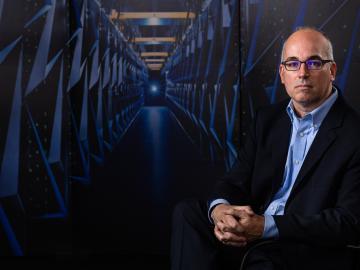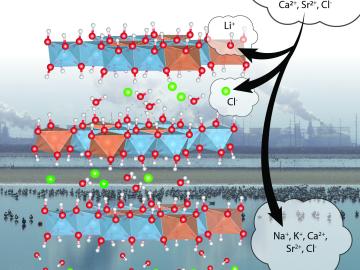
Filter News
Area of Research
- (-) Clean Energy (522)
- (-) Supercomputing (311)
- Advanced Manufacturing (34)
- Biological Systems (18)
- Biology and Environment (177)
- Biology and Soft Matter (5)
- Building Technologies (12)
- Chemical and Engineering Materials (4)
- Chemistry and Physics at Interfaces (11)
- Climate and Environmental Systems (14)
- Computational Biology (6)
- Computational Chemistry (5)
- Computational Engineering (5)
- Computer Science (19)
- Data (1)
- Earth Sciences (1)
- Electricity and Smart Grid (3)
- Energy Frontier Research Centers (14)
- Energy Sciences (5)
- Fossil Energy (3)
- Fuel Cycle Science and Technology (3)
- Functional Materials for Energy (16)
- Fusion and Fission (54)
- Fusion Energy (17)
- Geographic Information Science and Technology (3)
- Isotope Development and Production (3)
- Isotopes (35)
- Materials (433)
- Materials Characterization (2)
- Materials for Computing (36)
- Materials Synthesis from Atoms to Systems (13)
- Materials Under Extremes (12)
- Mathematics (1)
- National Security (79)
- Neutron Data Analysis and Visualization (4)
- Neutron Science (190)
- Nuclear Science and Technology (74)
- Nuclear Systems Modeling, Simulation and Validation (3)
- Nuclear Systems Technology (1)
- Quantum Condensed Matter (4)
- Quantum information Science (9)
- Reactor Technology (1)
- Renewable Energy (4)
- Sensors and Controls (5)
- Transportation Systems (11)
News Type
News Topics
- 3-D Printing/Advanced Manufacturing (80)
- Advanced Reactors (7)
- Artificial Intelligence (41)
- Big Data (24)
- Bioenergy (29)
- Biology (19)
- Biomedical (22)
- Biotechnology (6)
- Buildings (37)
- Chemical Sciences (16)
- Clean Water (8)
- Climate Change (35)
- Composites (17)
- Computer Science (107)
- Coronavirus (25)
- Critical Materials (12)
- Cybersecurity (14)
- Decarbonization (35)
- Energy Storage (75)
- Environment (68)
- Exascale Computing (23)
- Fossil Energy (2)
- Frontier (28)
- Fusion (2)
- Grid (42)
- High-Performance Computing (39)
- Hydropower (2)
- Isotopes (1)
- Machine Learning (19)
- Materials (45)
- Materials Science (40)
- Mathematics (3)
- Mercury (3)
- Microelectronics (1)
- Microscopy (14)
- Molten Salt (1)
- Nanotechnology (15)
- National Security (11)
- Net Zero (4)
- Neutron Science (20)
- Nuclear Energy (11)
- Partnerships (12)
- Physics (7)
- Polymers (13)
- Quantum Computing (19)
- Quantum Science (25)
- Renewable Energy (1)
- Security (9)
- Simulation (16)
- Software (1)
- Space Exploration (6)
- Statistics (1)
- Summit (43)
- Sustainable Energy (71)
- Transformational Challenge Reactor (3)
- Transportation (69)
Media Contacts

Oak Ridge National Laboratory will partner with Cincinnati Children’s Hospital Medical Center to explore ways to deploy expertise in health data science that could more quickly identify patients’ mental health risk factors and aid in

The prospect of simulating a fusion plasma is a step closer to reality thanks to a new computational tool developed by scientists in fusion physics, computer science and mathematics at ORNL.

Energy storage startup SPARKZ Inc. has exclusively licensed five battery technologies from the Department of Energy’s Oak Ridge National Laboratory designed to eliminate cobalt metal in lithium-ion batteries. The advancement is aimed at accelerating the production of electric vehicles and energy storage solutions for the power grid.

An international team of researchers has discovered the hydrogen atoms in a metal hydride material are much more tightly spaced than had been predicted for decades — a feature that could possibly facilitate superconductivity at or near room temperature and pressure.

Peter Wang is focused on robotics and automation at the Department of Energy’s Manufacturing Demonstration Facility at ORNL, working on high-profile projects such as the MedUSA, a large-scale hybrid additive manufacturing machine.

After several years in the private sector exploring the unknown origins of neurodegenerative brain disorders such as Alzheimer’s, Chris Ellis thinks one of the keys to solving the mystery is at Oak Ridge National Laboratory: the world’s most powerful supercomputer.

The formation of lithium dendrites is still a mystery, but materials engineers study the conditions that enable dendrites and how to stop them.

A team from the ORNL has conducted a series of experiments to gain a better understanding of quantum mechanics and pursue advances in quantum networking and quantum computing, which could lead to practical applications in cybersecurity and other areas.

In the quest for domestic sources of lithium to meet growing demand for battery production, scientists at ORNL are advancing a sorbent that can be used to more efficiently recover the material from brine wastes at geothermal power plants.

Scientists at have experimentally demonstrated a novel cryogenic, or low temperature, memory cell circuit design based on coupled arrays of Josephson junctions, a technology that may be faster and more energy efficient than existing memory devices.


